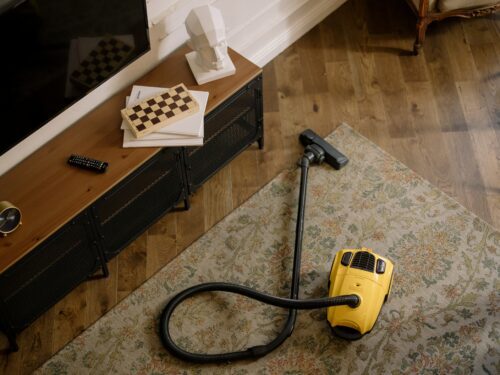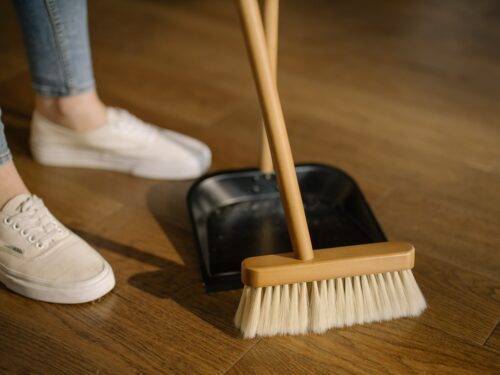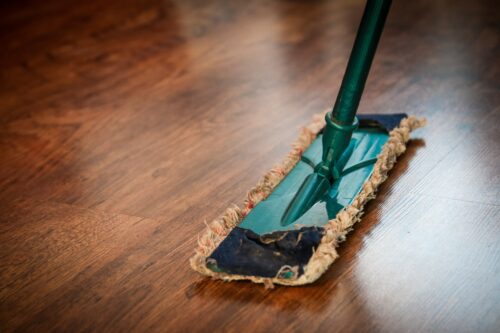How to Clean LVT Flooring in STEPS
Luxury vinyl tiles give you the realistic look of a wooden or stone floor, whilst being waterproof and resistant to damage, making them ideal for light commercial settings and home interiors, including bathroom and kitchen flooring.
Of course, with all that foot traffic comes dirt, grime, and other messes that need to be removed to prevent them from becoming health and safety risks. We’ll look at how to clean LVT flooring without leaving scuff marks and scratches in the process.
You can add a touch of elegance to your flooring, with our selection of textures and attractive designs. You can browse our products to find a style that suits you, or get in touch with our team. We’ll be more than happy to help!
In this post, we’ll cover everything you need to know on how to clean LVT flooring using a step-by-step guide, with handy tips and tricks to keep your new flooring looking sharper for longer. We’ll cover the do’s and don’ts of maintaining your luxury vinyl tiles, cleaning products to avoid and more!

Tips for Cleaning LVT Flooring
Vinyl flooring is designed to be low-maintenance. Being non-porous, luxury vinyl tiles are usually waterproof, making them great at repelling a range of things that could damage wooden floors or carpeting. Indeed, most spills and splashes onto vinyl can be wiped away immediately with a simple microfibre cloth or a few sheets of kitchen roll.
Not everything is so easy to clean off though. Sometimes you need a bit more effort to remove stains from vinyl. Ground-in dirt may leave you with no option but to try deep-cleaning LVT floors instead. Fortunately, all these problems can be easily resolved with the following hints and tips.
Products to avoid when cleaning luxury vinyl tile flooring
Some cleaning products are just not suitable for cleaning LVT floors. It’s not that they aren’t effective cleaning solutions for any other kind of surface; they are simply known for damaging luxury vinyl tiles. These are some of the items you should avoid at all costs:
Ammonia-based products: these include several types of household bleach and other disinfectants. Ammonia reacts badly with vinyl, causing the top layer to harden and crack. Not only is this unsightly, but it also stops the vinyl from being water-resistant.
Abrasive cleaning tools: everything from beater bars on a vacuum cleaner to scrubbing brushes, scouring pads, and steel wool can cause damage if used on a vinyl floor tile. There are certain cleaning products that clean through abrasion, which should also be avoided.
Steam cleaners: while LVT flooring can resist the water left behind by a steam cleaner, the heat itself can cause serious damage. It can cause the adhesive to melt and the vinyl flooring to curl back on itself. The heat can also cause the vinyl to become brittle and crack.
Which cleaning products are safe for luxury vinyl tile flooring?
While there are plenty of commercial floor cleaning products available to buy in stores, you can often get just as good an effect with a homemade cleaner. A simple vinegar and water solution helps remove the most common stains from your LVT flooring, without the risk of causing damage.
While this mixture of clean water and apple cider vinegar (or white vinegar) is non-toxic and highly effective, some people don’t like the smell it gives off. An alternative is to swap the vinegar for freshly squeezed lemon juice. It has the same effect with a fresher scent.

Step-by-step guide on how to clean LVT flooring
Once you’ve got the right tools for the job, there are a few steps to getting your LVT flooring spic and span. Follow our guide for the best results:
- When using any cleaning product for the first time, test it first to see how your luxury vinyl flooring reacts. Before installation, save yourself a spare tile, so you can use it for testing purposes.
- Another thing to be wary of is that even non-slip surfaces like LVT can become slip hazards when wet. If you’re cleaning at home, be sure to let any other family members or housemates know that the floor is wet. If cleaning is being done at work, the appropriate ‘Wet Floor’ signs should be erected.
- Before you even get started with cleaning solutions, you’ll need to sweep your floor. Once you’ve swept away any loose dust or dirt, you can give the floor a light mopping with no detergent in the water. This is a simple surface wash to remove the lighter dirt from the floor, giving you a great base from which to start your deep cleaning.
- Once you are satisfied, empty and refill your mop bucket, adding a little detergent to the water or the vinegar and water solution mentioned above. If you’ve been looking after your floor properly, a light detergent and a bit of effort with the mop should be enough to remove any markings from the floor.
- Every now and then, you will have deep stains on your LVT that even your trusted vinegar and water solution won’t shift. You don’t want to wreck the vinyl by scrubbing at it or risk using bleach, so what’s our answer? Nail polish remover. Specifically, the acetone in everyday nail polish remover does an incredible job of removing stains from vinyl without damaging the integrity of the flooring.While it is effective, you can’t just apply and remove it with a mop. You’ll need to tackle the stain a bit at a time. Soak a cotton wool pad with nail polish remover and use it to gently rub away at the stain. It may take some time, but the results will be worth it.
The Do’s and Don’ts of Maintaining Clean LVT Flooring
The easiest way to keep clean LVT floors is to adopt a regular maintenance regime. Light cleaning on a frequent basis will often forgo the need to deep clean your floors, as dirt and grime won’t get a chance to stick around.
Here are some useful DOs and DON’Ts for you to consider:
DO clean up spills immediately: standing water is not just a slip hazard on vinyl floors; it can also lead to stains that are hard to get out. A quick wipe-up with a microfiber cloth or a damp mop frequently resolves the issue.
DON’T use cleaning products that can damage vinyl: bleach and other ammonia-based cleaners will damage your tiles over time, while abrasive cleaners can cause scuff marks and other surface damage even while you’re using them.
DO protect your LVT floors: invest in foot pads for your furniture to prevent them from leaving dents in your LVT floor. Place a mat at the entrance to the room for people to wipe their feet on, to avoid tracking in dirt and grime.
DON’T use the wrong tools for cleaning your floor: the beater bar on your vacuum cleaner can leave scratches on your vinyl tiles, as can abrasive tools like steel wool, scouring pads, and scrubbing brushes. Use a soft cloth for cleaning and a soft broom for sweeping.
DO polish your LVT flooring regularly: polishing your floor gives it a pleasant sheen and keeps it looking like new. Be sure to choose a product that is properly formulated for use with luxury vinyl tiles.
DON’T abuse your floor: there are plenty of small precautions you can take to limit the risk of rips and tears. Don’t wear high heels on vinyl floors, for instance, and get your pets’ nails clipped on a regular basis.
DO keep your LVTs dry: we’ve discussed this earlier when talking about spillages, but vinyl floors are only non-slip while they remain dry. A damp vinyl floor is a major slip hazard.
DON’T expose your floor to direct sunlight: vinyl tends to fade when left in the sun for too long. Ultraviolet rays leach the colour out of your tiles, leaving them looking drab and washed out. Make sure to shade large rooms with curtains or blinds on particularly sunny days.
We hope this guide on how to clean LVT flooring answers all your burning questions, and if we’ve missed anything get in touch today and we’ll be happy to help!
When buying vinyl tiles from AFloor, you can expect a durable and long-lasting flooring solution. For more tips on how to install LVT flooring follow our step-by-step guide, or if you want to know how you can keep your vinyl flooring looking its best for longer take a look at our restoration guide for LVT flooring. Use these tips above to ensure years of productive use from your tiles. For more details, check our online store.

